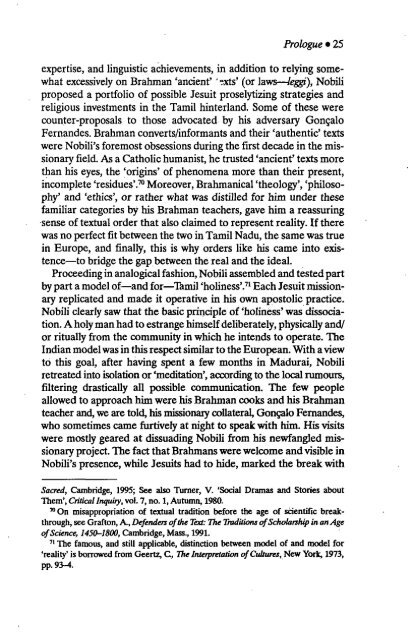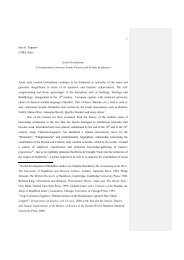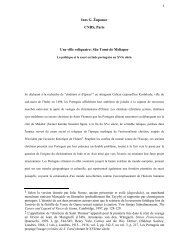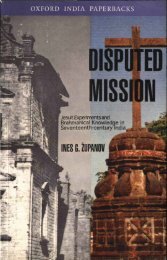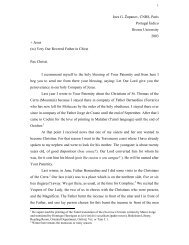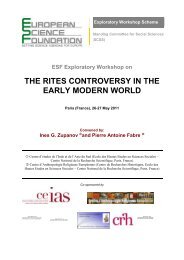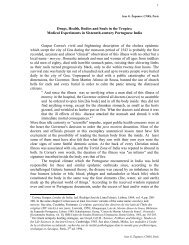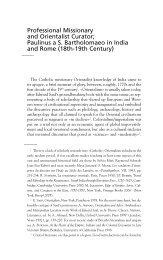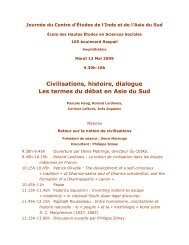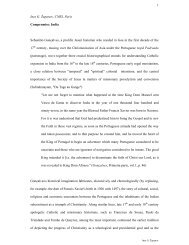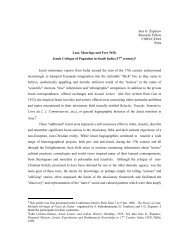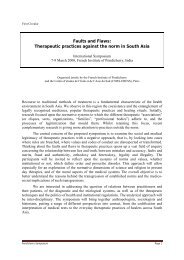INES G. ZUPANOV - Ines G. Županov
INES G. ZUPANOV - Ines G. Županov
INES G. ZUPANOV - Ines G. Županov
You also want an ePaper? Increase the reach of your titles
YUMPU automatically turns print PDFs into web optimized ePapers that Google loves.
Prologue • 25<br />
expertise, and linguistic achievements, in addition to relying somewhat<br />
excessively on Brahman 'ancient' ' =;xts' (or laws—leggi), Nobili<br />
proposed a portfolio of possible Jesuit proselytizing strategies and<br />
religious investments in the Tamil hinterland. Some of these were<br />
counter-proposals to those advocated by his adversary Gonçalo<br />
Fernandes. Brahman converts/informants and their 'authentic' texts<br />
were Nobili's foremost obsessions during the first decade in the missionary<br />
field. As a Catholic humanist, he trusted 'ancient' texts more<br />
than his eyes, the 'origins' of phenomena more than their present,<br />
incomplete 'residues'. 70 Moreover, Brahmanical 'theology', 'philosophy'<br />
and 'ethics', or rather what was distilled for him under these<br />
familiar categories by his Brahman teachers, gave him a reassuring<br />
sense of textual order that also claimed to represent reality. If there<br />
was no perfect fit between the two in Tamil Nadu, the same was true<br />
in Europe, and finally, this is why orders like his came into existence—to<br />
bridge the gap between the real and the ideal.<br />
Proceeding in analogical fashion, Nobili assembled and tested part<br />
by part a model of—and for—Tamil 'holiness'. 71 Each Jesuit missionary<br />
replicated and made it operative in his own apostolic practice.<br />
Nobili clearly saw that the basic principle of 'holiness' was dissociation.<br />
A holy man had to estrange himself deliberately, physically and/<br />
or ritually from the community in which he intends to operate. The<br />
Indian model was in this respect similar to the European. With a view<br />
to this goal, after having spent a few months in Madurai, Nobili<br />
retreated into isolation or 'meditation', according to the local rumours,<br />
filtering drastically all possible communication. The few people<br />
allowed to approach him were his Brahman cooks and his Brahman<br />
teacher and, we are told, his missionary collateral, Gonçalo Fernandes,<br />
who sometimes came furtively at night to speak with him. His visits<br />
were mostly geared at dissuading Nobili from his newfangled missionary<br />
project. The fact that Brahmans were welcome and visible in<br />
Nobili's presence, while Jesuits had to hide, marked the break with<br />
Sacred, Cambridge, 1995; See also Turner, V. 'Social Dramas and Stories about<br />
Them', Critical Inquiry, vol. 7, no. 1, Autumn, 1980.<br />
70 On misappropriation of textual tradition before the age of scientific breakthrough,<br />
see Graf ton, A-, Deferidas of the Text: The Traditions of Scholarship in an Age<br />
of Science, 1450-1800, Cambridge, Mass., 1991.<br />
71 The famous, and still applicable, distinction between model of and model for<br />
'reality' is borrowed from Geertz, C, The Interpretation of Cultures, New York, 1973,<br />
pp. 9S-4.


